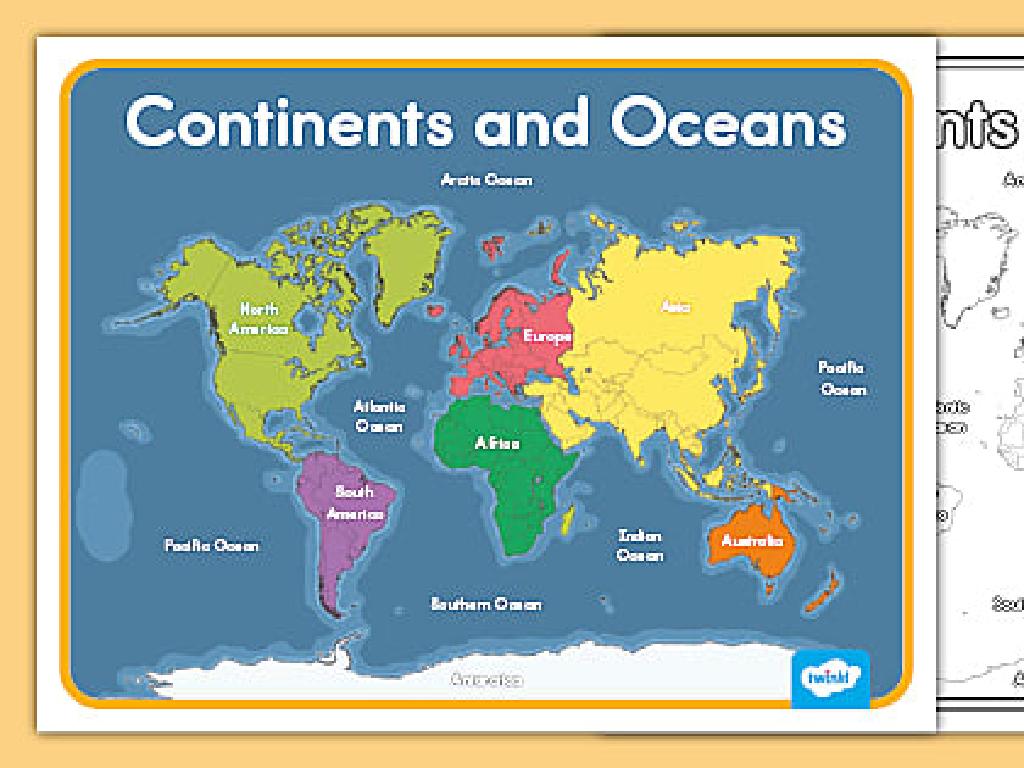Identify And Select Countries Of South America
Subject: Social studies
Grade: Seventh grade
Topic: The Americas: Geography
Please LOG IN to download the presentation. Access is available to registered users only.
View More Content
Welcome to South America!
– Explore the South American continent
– A diverse continent with 12 sovereign countries
– Geography’s role in global understanding
– Geography shapes cultures, economies, and politics
– Identifying countries of South America
– Learn to locate and name all South American nations
– Engage with the map of South America
|
This slide introduces students to the continent of South America, setting the stage for a deeper dive into its geography and the importance of geographical knowledge. Emphasize that South America is a diverse continent with a rich tapestry of cultures, languages, and natural landscapes. Highlight how geography influences various aspects of life and is crucial for understanding global relationships and history. The lesson will focus on identifying and selecting the countries of South America, which will help students to become more familiar with the political map of the continent. Encourage students to actively participate by engaging with a map of South America, either digitally or on paper, to reinforce their learning.
Exploring South America’s Geography
– Examine South America’s map
– Focus on the continent’s layout and physical features.
– Major geographical features
– Andes Mountains, Amazon Basin, and Atacama Desert.
– Meet South America’s countries
– Learn the names and locations of all 12 countries.
– Significance of geography
|
This slide aims to familiarize students with the physical map of South America, highlighting its major geographical features such as the Andes Mountains, the Amazon Basin, and the Atacama Desert. It also serves as an introduction to the 12 countries that make up the continent. Encourage students to observe the diverse terrain and discuss how geography might influence the culture and daily life in these countries. This will set the foundation for understanding the importance of geography in the context of South America’s history, economy, and development.
Exploring South America: Countries and Capitals
– List South American countries
– Brazil (Brasília), Argentina (Buenos Aires), and more
– Capitals and fun facts
– Languages like Portuguese, Spanish; Brazil’s large population
– Cultural diversity
– From Andean music to Amazon tribes, a cultural mosaic
– Geographical diversity
– Amazon rainforest, Andes mountains, Atacama Desert
|
This slide aims to familiarize students with the countries of South America and their capitals, providing a foundation for understanding the continent’s cultural and geographical diversity. Encourage students to memorize the countries and capitals. Fun facts like the predominance of Spanish and Portuguese languages, Brazil’s significant population, and unique features of each country will engage students. Highlight the rich cultural diversity, from traditional dances to indigenous communities, and the varied geography, including the world’s largest rainforest, longest mountain range, and driest desert. This overview sets the stage for deeper exploration into the history, culture, and physical geography of South America.
Geographical Wonders of South America
– Andes Mountains’ influence
– World’s longest mountain range affecting weather and human activity.
– Amazon River’s ecosystem role
– Largest river by discharge, home to diverse species, crucial for the environment.
– Atacama Desert’s uniqueness
– Known as the driest non-polar place, offers unique studies in adaptation.
– Impact on climate and culture
– Geography shapes regional climates and cultural practices, e.g., agriculture, festivals.
|
This slide aims to introduce students to the major geographical features of South America and their profound impact on the continent’s climate, culture, and ecosystem. The Andes Mountains, as the world’s longest mountain range, create varied climates and influence the way of life for many South American cultures. The Amazon River is vital for its biodiversity and environmental significance, supporting countless species and ecosystems. The Atacama Desert, being one of the driest places on Earth, provides a stark contrast to the lushness of the Amazon and offers insights into extreme ecological adaptations. Discuss how these features shape the climate patterns and cultural practices, such as agriculture, architecture, and local festivals. Encourage students to think about how living near these features would influence their daily lives.
Climate Zones of South America
– Identify continent’s climate zones
– Tropical, dry, temperate, polar zones
– Geography’s impact on climate
– Mountains, forests, and coasts shape climate
– Climate’s effect on daily life
– Farming, clothing, and activities vary with climate
– Cultural influences of climate
– Festivals and food reflect climatic conditions
|
This slide aims to educate students on the diverse climate zones of South America and how these zones are influenced by the continent’s geography. Students should learn to identify the main climate zones, such as tropical, dry, temperate, and polar, and understand how geographical features like the Andes Mountains and the Amazon Rainforest contribute to these climates. Discuss how the climate affects the daily lives of people, including their farming practices, the clothes they wear, and their recreational activities. Highlight how climate has shaped the cultural aspects of South American societies, influencing everything from festivals to cuisine. Encourage students to explore specific examples and consider how their own lives might differ in another climate zone.
Economic Activities in South America
– Main economic activities overview
– Agriculture, mining, and tourism are vital
– Geography’s impact on economy
– Mountains, rivers, and forests shape industries
– Case studies: Brazil & Argentina
– Brazil’s agriculture vs. Argentina’s beef industry
– Diverse economies across the continent
|
This slide aims to explore the various economic activities that are prevalent in South America and how the continent’s diverse geography influences these economic opportunities. Students should understand that agriculture, including crops like coffee and soybeans, is significant in countries like Brazil, while mining activities are prominent in Chile and Peru. Tourism also plays a crucial role due to natural wonders like the Amazon rainforest and Andes mountains. Highlight the case studies of Brazil’s booming agricultural sector and Argentina’s renowned beef industry to provide concrete examples. Encourage students to think about how the physical landscape of a country can shape its economic strengths and the variety of economies that exist across South American countries.
Class Activity: Mapping Challenge
– Receive a blank map of South America
– Label each South American country
– Apply today’s lesson knowledge
– Collaborate with a classmate
Discuss with your partner to find answers
|
This activity is designed to reinforce the students’ knowledge of South American geography. By working with a blank map, students will actively recall the countries discussed in the lesson. Encourage them to use spatial memory and any mnemonic devices they’ve learned. Collaboration with peers will help them to learn from each other and confirm their answers. Possible variations of the activity for different pairs could include: focusing on capital cities, major geographical features like rivers and mountains, or even population sizes. This will cater to different learning styles and keep the activity dynamic. Assess the students’ maps at the end to ensure they’ve grasped the lesson’s content.
Conclusion: South America’s Geography
– Review South American countries
– Capitals of South America
– Geography’s role in comprehension
– Understanding geography helps us grasp cultural, political, and environmental aspects.
– Engage in Q&A session
– Clarify doubts, reinforce knowledge.
|
As we wrap up today’s lesson, let’s go over the countries of South America and their capitals to ensure everyone is clear on the geography of the continent. Emphasize the importance of geography in understanding not just the physical layout, but also how it influences the culture, politics, and environment of South America. Encourage students to ask questions during the Q&A session to clarify any doubts they may have. This will help solidify their learning and ensure they are confident in identifying and selecting the countries of South America. Consider using a map to visually assist in the recap and to make the Q&A session more interactive.






